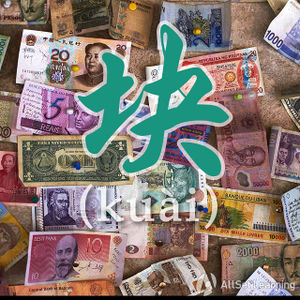Difference between revisions of "Counting money"
| Line 27: | Line 27: | ||
<div class="liju"> | <div class="liju"> | ||
| + | * 一 <em>块</em> 七<span class="pinyin">yī <em>kuài</em> qī</span><span class="trans">One kuai seven mao (1.7)</span> | ||
* 三 <em>块</em> 八<span class="pinyin">sān <em>kuài</em> bā </span><span class="trans">Three kuai eight (3.8)</span> | * 三 <em>块</em> 八<span class="pinyin">sān <em>kuài</em> bā </span><span class="trans">Three kuai eight (3.8)</span> | ||
| − | |||
* 九 <em>块</em> 五<span class="pinyin">jiǔ <em>kuài</em> wǔ</span><span class="trans">Nine kuai five mao (9.5)</span> | * 九 <em>块</em> 五<span class="pinyin">jiǔ <em>kuài</em> wǔ</span><span class="trans">Nine kuai five mao (9.5)</span> | ||
| − | |||
| − | |||
| − | |||
* 二 十 三 <em>块</em> 八<span class="pinyin">èr shí sān <em>kuài</em> bā</span><span class="trans">Twenty-three kuai eight mao (23.8)</span> | * 二 十 三 <em>块</em> 八<span class="pinyin">èr shí sān <em>kuài</em> bā</span><span class="trans">Twenty-three kuai eight mao (23.8)</span> | ||
| − | * | + | * 六 十 <em>块</em> 五<span class="pinyin">wǔ shí <em>kuài</em> wǔ</span><span class="trans">Fifty kuai five mao (50.5)</span> |
| − | * | + | * 八 十 二 <em>块</em> 四<span class="pinyin">bāshí'èr <em>kuài</em> sì</span><span class="trans">Eighty-two kuai four mao (82.4)</span> |
| − | |||
</div> | </div> | ||
Revision as of 09:49, 2 November 2015
-
Level
-
Similar to
-
Used for
-
Keywords
Cash rules everything around us, and in China there's no exception. Mastering how to say quantities of money is vital!
Structure
Chinese has a specific structure for talking about quantities for money:
Number + 块 + Number + 毛
Examples
- 三 块 八 毛 three kuai eight mao (3.8)
- 十 块 两 毛 ten kuai two mao (10.2)
- 九 块 五 毛 nine kuai five mao (9.5)
- 一 块 七 毛 one kuai seven mao (1.7)
- 五 十 块 五 毛 fifty kuai five mao (50.5)
If the smaller units are only in tens, you can just say the number of tens. So 3.86 RMB is "三 块 八 (sān kuài bā)". Also this way of speaking is normally only used in matters with less than 100.
- 一 块 七One kuai seven mao (1.7)
- 三 块 八Three kuai eight (3.8)
- 九 块 五Nine kuai five mao (9.5)
- 二 十 三 块 八Twenty-three kuai eight mao (23.8)
- 六 十 块 五Fifty kuai five mao (50.5)
- 八 十 二 块 四Eighty-two kuai four mao (82.4)
The first number is the amount of whole RMB (or dollars etc.), and the second is the amount smaller units (e.g. cents). So 3.86 RMB is
- 三 块 八 毛 六three kuai eight mao six fen (3.86)
And if there's no smaller unit, e.g. 3 RMB, you can just say:
- 三 块 Three kuai
块 (kuài) is the more common, informal way to talk about money. More formally you can use 元 (yuán) in exactly the same way. This is similar to the difference between "dollars" and "bucks" in American English, or "pounds" and "quid" in British English. 块 (kuài) is appropriate in more situations than "bucks" or "quid", though.
See also
Sources and further reading
Books
- A Practical Chinese Grammar For Foreigners (外国人实用汉语语法) (pp. 88-9) →buy
- Integrated Chinese: Level 1, Part 1 (3rd ed) (pp. 233-4) →buy



